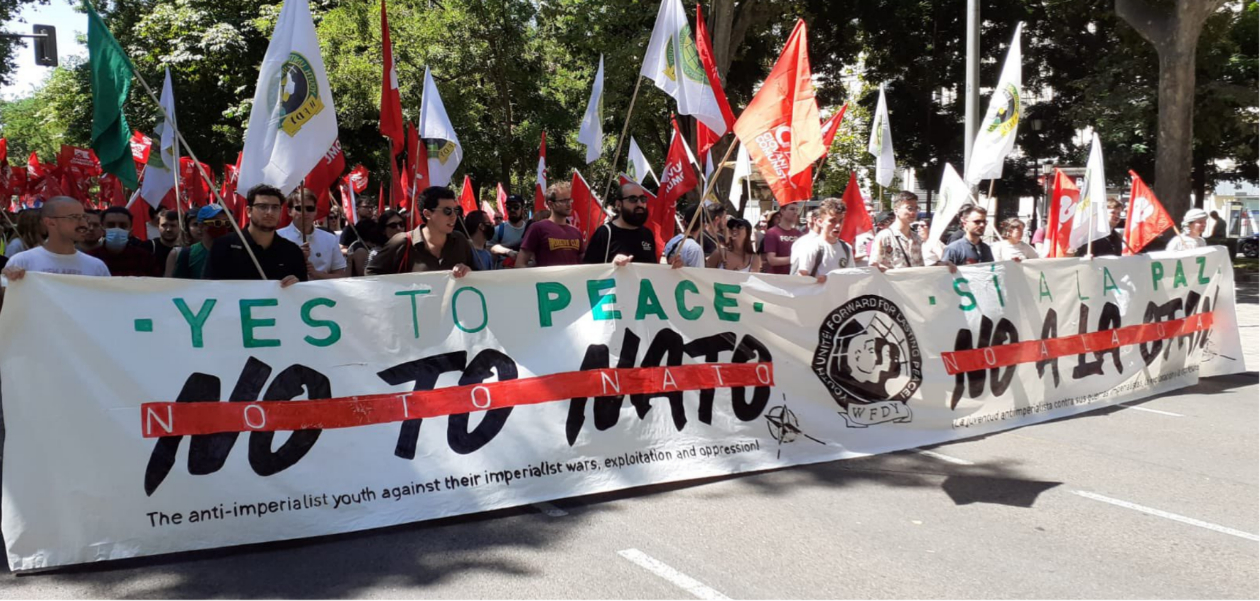
The NATO Summit taking place in Madrid June 29-30 “will be transformative,” asserted NATO Secretary-General Jens Stoltenberg; it will project “a new Strategic Concept for a new security reality.” That new reality will reportedly include a 750% increase in the size of the alliance’s standing military force—from the current 40,000 to 300,000 troops.
At its 50th anniversary summit in Washington in 1999, NATO expanded its Cold-War era mission of collective defense of Europe to include protection for democracy “within and beyond our borders.” Today, the guns of NATO still point at Russia, whose invasion of Ukraine has provided the rationale for the massive build-up.
According to Stoltenberg on June 27, NATO will provide “support to Ukraine now, and for the future.” He declared that the “Allies consider Russia as the most significant and direct threat to our security.”

The guns of NATO have always pointed at Moscow since the alliance’s founding, but today they also point even further eastward.
Stoltenberg said NATO “will address China for the first time…[and also] the challenges that Beijing poses to our security, interests, and values.” Pacific nations—Australia, Japan, the Republic of Korea, and New Zealand—will be attending a NATO summit for the first time.
The war conclave has already faced mass opposition in the streets before it even opens. A “Peace Summit,” described as “the People’s Alternative to NATO and War,” gathered in Madrid June 24-25.
A conglomeration of Spanish and European anti-capitalists, Communists, environmentalists, feminists, anti-imperialists, peace activists, and spokespersons for struggles in the global South attended workshops, panel discussions, cultural presentations, and plenary sessions. The World Federation of Democratic Youth was among the key organizers.
The Peace Summit issued an extensive list of demands. First was that NATO be disbanded. The indictment read: “NATO violates the U.N. Charter … authoritarian, fascist, and colonial regimes are included in its alliance … NATO’s military interventions have destabilized and destroyed Yugoslavia, Afghanistan, and Libya. Now NATO pursues a new Cold War against China and Russia. … NATO leads the worldwide arms race … NATO’s nuclear agenda greatly endangers our survival.”
Regarding environmental contamination: “The U.S. Army is the most contaminating institution on the planet … NATO generates poverty and inequalities.”
The Peace Summit then declared, “Yes, to Peace … we need a non-militarized system of security, without nuclear arms, without foreign bases, and with a drastic reduction of military expenses. We defend a politics of active peace … [We want] investment in social progress, not in war … Europe and North America must commit to disarmament.”
The statement concluded with an invitation: “March with us against NATO and for building a world of peace.” Indeed, on June 26 thousands marched through central Madrid, their banners flying. Organizers claimed 30,000 marchers.
The Communist Party of Spain (PCE) and the United Left (Izquierda Unida) were the only domestic political parties that joined with dozens of Spanish and international organizations endorsing the declaration and march. The PCE belongs to the United Left electoral coalition that, after the November 2019 general election, combined with the larger United We Can alliance (Unidas Podemos) to form a government under the leadership of Prime Minister Pedro Sánchez, head of the Socialist Party.
Sánchez issued a statement welcoming the NATO summit to Madrid. He mentioned concerns about Spain’s “southern flank,” a reference, presumably, to migrants from Africa.
PCE member Yolanda Díaz serves as labor minister and second deputy prime minister in Sánchez’s government. Even so, Enrique Santiago, secretary-general of her party, on June 7 offered ideas at odds with those of the prime minister: “We don’t want the NATO summit in Madrid. The story of the Ukraine conflict is of a war foretold, what with the continuing expansion of NATO to the East … And in wars, the peoples, the workers, always lose out.”
Santiago cited the risk of “nuclear confrontation” and commended the Peace Summit and “international demonstration against war on June 26.”
In remarks two days prior to the summit, Stoltenberg greatly heightened the urgency of the peace proponents’ fears. “At the summit,” he said, “we will strengthen our forward defenses. We will enhance our battle groups in the eastern part of the alliance.”
It was then that a report emerged predicting that “NATO allies will decide at a summit this week to increase the strength of their rapid reaction force nearly eightfold to 300,000 troops,” up from the current 40,000.
As part of efforts “to shore up the defenses on Europe’s eastern flank,” the NATO Summit is also expected to speed up arrangements for the entry of Finland and Sweden into the alliance.
Focusing specifically on the Russia-Ukraine war, Stoltenberg spoke of a “strengthened Comprehensive Assistance Package for Ukraine” and “about the [Russian] military build-up in Kaliningrad … with highly advanced weapon systems.” Partly because of Kaliningrad, he said, NATO must “modernize our armed forces, our capabilities, and also increase our presence in that part of the region.”
According to the Brookings Institute, Kaliningrad, a tiny Baltic Sea, Russian-controlled enclave, located between Poland and Lithuania, “could become a new flashpoint in Russia’s war on Ukraine.” That’s because Lithuania is blocking the passage of E.U.-sanctioned Russian goods into the territory for delivery beyond.
Under the terms of its massive military expansion, NATO will deploy troops in Estonia, Latvia, and Lithuania, with soldiers able to respond in 48 hours to any hypothetical invasion.
But the restructure will require a further increase in the NATO budget, with member states expected to increase military spending for the eighth consecutive year.
Under NATO membership rules, countries must currently spend at least 2% of their GDP on weapons and the military to reach spending targets which have increased by $350 billion since 2014.
The redirection of more funds away from public needs and toward war will put further pressure on already weakened economies, with inflation hitting record levels across Europe and the United States amid rising energy prices and the threat of impending recession.










